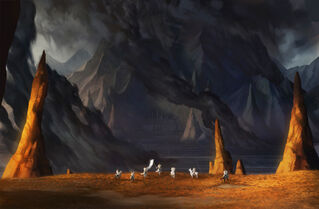
Thangorodrim was a group of three gigantic active volcanoes within the Iron Mountains in the north of Middle-earth during the First Age. They were raised by Morgoth, who delved his fortress of Angband beneath them and far back into the Iron Mountains. These volcanoes were the center of Morgoth's dark realm known as Dor-na-Daerachas, with Angband functioning as the capital. Before the destruction of Beleriand, they were the highest peaks in all of Middle-earth.
History
Thangorodrim was made up of three volcanoes which were said to have been crafted by Morgoth from the slag and debris of the re-delving of Angband during the First Age. The mountains themselves were of little consequence during Morgoth's rule of Angband, save to occasionally spew forth fire and magma when Morgoth was either exceptionally wrathful or launching an assault..
After the death of his father, Maedhros was taken prisoner and nailed to a cliff of Thangorodrim as a method of torture. He was rescued by his cousin Fingon with the help of Thorondor, King of the Eagles.[1] After his family was cursed by Morgoth, Húrin was imprisoned in a chair on a high terrace to watch the curse unfold.[2][3][4]
For a time immediately after the creation of Thangorodrim, the Great Eagles made their eyries on the three mountains[5] at the command of Manwë in order to bring him news of Morgoth's doings. However, at some time during the First Age the Eagles moved to the Crissaegrim near Gondolin.[6]
At the base of the south face of the middle peak was the Great Gate of Angband, a deep canyon leading into the mountain, lined with towers and forts. There were also a number of secret gates scattered around the sides of the mountain group, from which Morgoth's hosts could issue forth and surprise their foes.
Thangorodrim was destroyed during the War of Wrath at the end of the First Age when Ancalagon, freshly slain by Eärendil fell dead on the peaks and crushed them to rubble.[7]
Size
The exact size and height of Thangorodrim are unclear, though they were said to have been the tallest mountains in Middle-earth. One drawing by Tolkien illustrated in Karen Wynn Fonstad's The Atlas of Middle-earth, if drawn to scale, would have made each mountain 35,000 ft high and five miles across, and the statement that it lay 150 leagues (450 Númenórean miles) north of Menegroth puts it too far away for some of the action in The Silmarillion to make sense; a distance of 150–200 miles would have been more consistent. It is possible that with the higher figure Tolkien was not referring to 'as the eagle flies', but rather 'as the wolf runs': the plateau of Dorthonion forced a long detour, which added the extra 200 – 250 miles to the distance.[8]
Etymology
Thangorodrim was a compound Sindarin name, of the words for 'oppression', 'mountain', and 'group'; together meaning roughly 'Oppressive peaks'.[9]
Translations
| Foreign Language | Translated name |
| Amharic | ጥሃንጎሮድሪም |
| Arabic | طهانعورودريم |
| Armenian | Տհանգորոդրիմ |
| Belarusian Cyrillic | Тангарадрым |
| Bengali | ঠাঙরদ্রিম |
| Bulgarian Cyrillic | Тхангородрим |
| Chinese (Hong Kong) | 安戈洛墜姆 |
| Danish | Thangorodrim ("Undertrykkelsens Bjerge") |
| Georgian | თანგოროდრიმი |
| Greek | Θανγκορόντριμ |
| Gujarati | ઠઙોરોદ્રિમ |
| Hebrew | תאנגורודרים |
| Hindi | ठङोरोद्रिम |
| Japanese | タンゴロドリム |
| Kannada | ಥಂಗೊರೊಡ್ರಿಮ್ |
| Kazakh Cyrillic | Тһангородрім |
| Korean | 상고로드림 |
| Kyrgyz Cyrillic | Тhангородрим |
| Laotian | ຖຮະງໂຣໂດຣິມ |
| Macedonian Cyrillic | Тангородрим |
| Nepalese | ठङोरोद्रिम |
| Pashto | طهانګورودریم |
| Persian | تانگورودریم |
| Russian | Тангородрим |
| Sanskrit | ठङोरोद्रिम् |
| Serbian | Тангородрим (Cyrillic) Tangorodrim (Latin) |
| Sinhalese | ඨඞොරොද්රිම් |
| Tajik Cyrillic | Тҳангородрим |
| Tamil | தன்கோரோட்ரிம் |
| Telugu | ఠఙొరొద్రిమ |
| Thai | ธังโกโรดริม |
| Ukrainian Cyrillic | Тангородріма |
| Urdu | طهانگورودریم ? |
| Uzbek | Тҳангородрим (Cyrillic) Thangorodrim (Latin) |
| Yiddish | תּהאַנגאָראָדרים |
References
- ↑ The Silmarillion, Quenta Silmarillion, Chapter XIII: "Of the Return of the Noldor"
- ↑ The Silmarillion, Quenta Silmarillion, Chapter XX: "Of the Fifth Battle: Nirnaeth Arnoediad"
- ↑ The Children of Húrin, Narn i Chîn Húrin, The Tale of the Children of Húrin, II: "The Battle of Unnumbered Tears"
- ↑ The Children of Húrin, Narn i Chîn Húrin, The Tale of the Children of Húrin, III: "The Words of Húrin and Morgoth"
- ↑ The Silmarillion, Quenta Silmarillion, Chapter I: "Of the Beginning of Days"
- ↑ Unfinished Tales, Part One: The First Age, I: "Of Tuor and his Coming to Gondolin"
- ↑ The Silmarillion, Quenta Silmarillion, Chapter XXIV: "Of the Voyage of Eärendil and the War of Wrath"
- ↑ The Atlas of Middle-earth, The First Age, The Elder Days, "Thangorodrim"
- ↑ The Complete Guide to Middle-earth